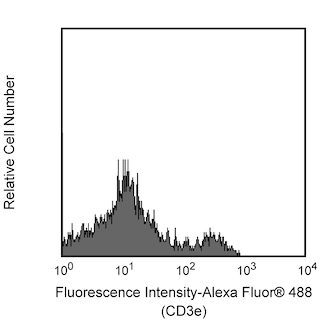-
Your selected country is
Middle East / Africa
- Change country/language
Old Browser
This page has been recently translated and is available in French now.
Looks like you're visiting us from {countryName}.
Would you like to stay on the current country site or be switched to your country?




Immunofluorescent Staining using BD Horizon™ BV421 Goat Anti-Rat Ig. Left Panel: Multicolor image analysis of CD3e+ CD4+ cells within mouse spleen. Mouse spleen cryosections (5 μm) were fixed with BD Cytofix™ Fixation Buffer (Cat. No. 554655), blocked with 5% Goat serum and 1% BSA diluted in 1x PBS, and stained with Purified Rat Anti-Mouse CD4 antibody (Cat. No. 553043) at 2.5 μg/mL. After washing, the sections were secondarily stained with BD Horizon BV421 Goat Anti-Rat Ig (Cat. No. 565013; pseudo-colored green; Upper Right Image) at 2.5 μg/mL. Sections were then washed and counterstained with Alexa Fluor® 488 Hamster Anti-Mouse CD3e antibody (Cat. No. 557666; pseudo-colored red; Upper Left) and DRAQ5™; pseudo-colored blue; Lower Left) as a nuclear stain. Slides were mounted with ProLong® Gold and the images were captured on a BD Pathway™ 435 Cell Analyzer (epifluorescence microscope) and merged using BD Attovision™ Software (Lower Right). 20X objective. Right Panel: Flow cytometric analysis of CD8b.2 or CD45R/B220 expression on mouse splenocytes. Mouse splenic leucocytes were either not stained with a primary antibody (control staining; dashed line histogram) or stained with Purified Rat Anti-Mouse CD8b.2 antibody (Cat. No. 553038; solid line histogram; Upper Plot) or Purified Rat Anti-Mouse CD45R/B220 antibody (Cat. No. 553084/557390; solid line histogram; Lower Plot), as indicated. The cells were washed and secondarily stained with BD Horizon BV421 Goat Anti-Rat Ig. Fluorescence histograms showing either CD8b.2 or CD45R/B220 expression (or control staining) were derived from gated events with the forward and side light-scatter characteristics of viable leucocytes. Flow cytometric analysis was performed using a BD LSRFortessa™ Cell Analyzer.


BD Horizon™ BV421 Goat Anti-Rat Ig

Regulatory Status Legend
Any use of products other than the permitted use without the express written authorization of Becton, Dickinson and Company is strictly prohibited.
Preparation And Storage
Product Notices
- Since applications vary, each investigator should titrate the reagent to obtain optimal results.
- An isotype control should be used at the same concentration as the antibody of interest.
- Caution: Sodium azide yields highly toxic hydrazoic acid under acidic conditions. Dilute azide compounds in running water before discarding to avoid accumulation of potentially explosive deposits in plumbing.
- Source of all serum proteins is from USDA inspected abattoirs located in the United States.
- Pacific Blue™ is a trademark of Molecular Probes, Inc., Eugene, OR.
- DRAQ5™ is a registered trademark of BioStatus Ltd.
- For fluorochrome spectra and suitable instrument settings, please refer to our Multicolor Flow Cytometry web page at www.bdbiosciences.com/colors.
- Please refer to www.bdbiosciences.com/us/s/resources for technical protocols.
Companion Products






BD Horizon™ BV421 Goat Anti-Rat Ig is intended to be a second-step reagent for immunofluorescent staining of cells pre-stained with Rat Ig primary antibodies. It also stains rat B cells and has little reactivity with rat non-B cells or mouse splenocytes. As a second step, it is reactive with rat IgG and IgM monoclonal antibodies although a weaker signal may be detected when the primary antibody has a rat IgM or IgG2b isotype due to its adsorption with mouse Ig. It has weak crossreactivity detectable by flow cytometry with some, but not all, hamster immunoglobulins.
The antibody was conjugated to BD Horizon BV421 which is part of the BD Horizon Brilliant™ Violet family of dyes. BD Horizon BV421 has an Ex Max at 407 nm and Em Max at 421 nm. The use of a mounting reagent (eg, ProLong® Gold) is highly recommended to maximize the photostability of BV421.
For confocal microscopy systems, a 405 nm laser is the optimal excitation source with optimal emission collection centered at 421 nm.
For epifluorescence microscopes with broad spectrum excitation sources, the recommended excitation and emission filters are 392/23 nm and 430/24 nm bandpass filters, respectively. For specific multicolor imaging applications, the exact filter configurations should be optimized by the end user. For additional instrument/filter configuration information, please visit http://www.bdbiosciences.com/research/cellularimaging.
For flow cytometry, BD Horizon BV421 can be excited by the violet laser and detected in the standard Pacific Blue™ filter set (eg, 450/50-nm filter).

Please refer to Support Documents for Quality Certificates
Global - Refer to manufacturer's instructions for use and related User Manuals and Technical data sheets before using this products as described
Comparisons, where applicable, are made against older BD Technology, manual methods or are general performance claims. Comparisons are not made against non-BD technologies, unless otherwise noted.
For Research Use Only. Not for use in diagnostic or therapeutic procedures.
Report a Site Issue
This form is intended to help us improve our website experience. For other support, please visit our Contact Us page.